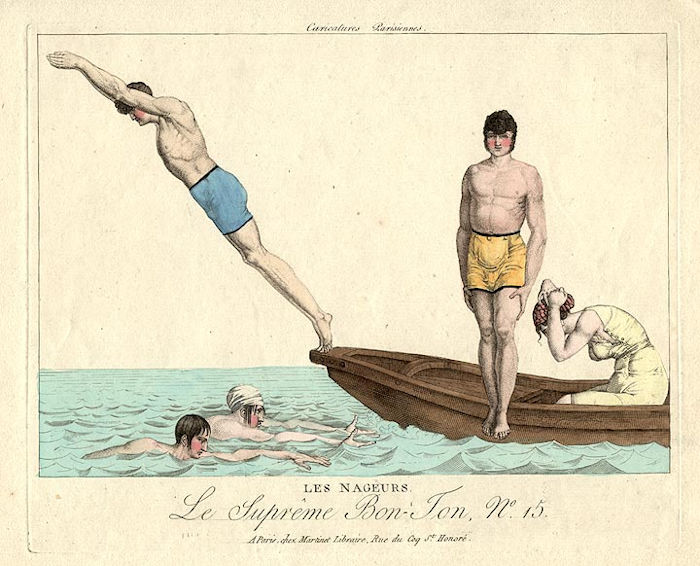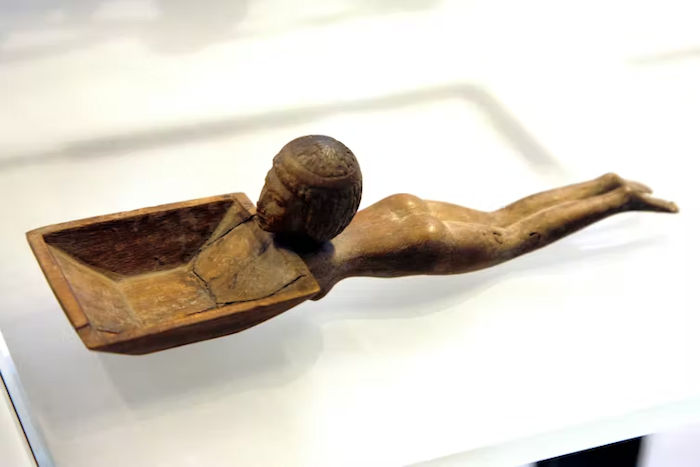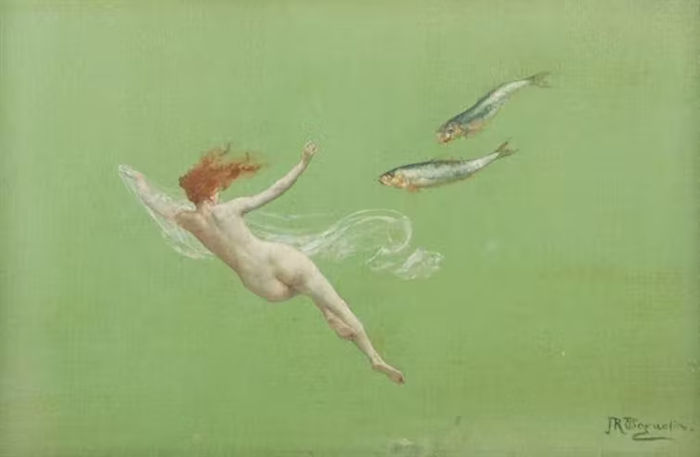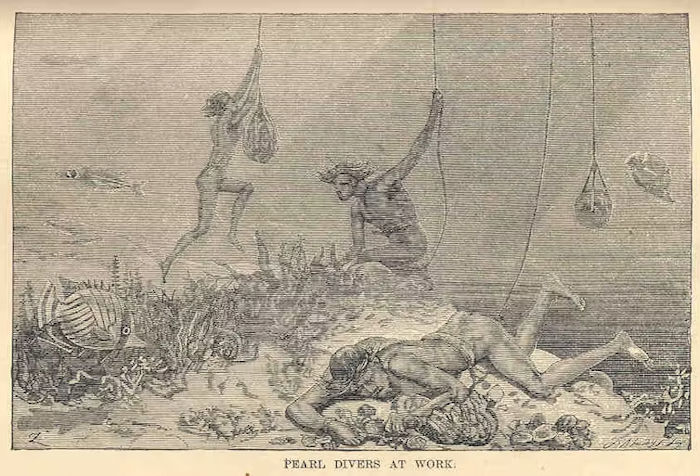Intriguing And Suprising Ancient History Of Swimming That Started Over 100,000 Years Ago
AncientPages.com - One of my life’s aims is to swim in as many lakes, rivers, pools and oceans as I possibly can, to use my liberty and swimming skills as freely as I can. I love the feeling of being in a large, fresh body of water, its soft immersive, vast or deep buoyancy.
Les Nageurs (The Swimmers), from the series Le Supreme Bon Ton, c. 1810–1815. Credit: Public Domain
I’ve swum in a freshwater lagoon near Acapulco in Mexico, with the guide reassuring us there were no crocodiles in the water that day. I’ve swum in a busy London indoor pool noisy with swimmers thrashing about and in Australia’s only women’s pool. I’ve swum in the Weisser See lake on the outskirts of Berlin, the same lake that my grandmother swam in, before fleeing Germany. At Jaffa’s Alma/al-Manshiyah Beach, in Tel Aviv, I’ve looked up from the sea to the Mahmoudiya Mosque’s minaret.
I’ve marvelled at finding myself in waters so far from home. It turns out that my ability to swim makes me part of an elite.
Karen Eva Carr opens Shifting Currents with the startling information that today worldwide – for all Earth’s many rivers, creeks, lakes, ponds, seas and oceans, to say nothing of built pools, canals and theme parks – the majority of people can’t swim. People might bathe and wash their clothes in rivers and lakes, or undertake ritual ablutions in bathhouses, but the vast majority must keep their feet on the ground.
Yet the earliest humans from over 100,000 years ago taught themselves how to swim, for food and for pleasure. There is a long history of human swimming for utility and leisure, amply recorded in pictures from the earliest cave drawings and folk narratives.
This year the OECD reported that only one in four people in low-income countries can swim. Low to middle-income countries report more non-swimmers than swimmers, and a majority of those not able to swim are girls and women.
Access to natural waterways has decreased world-wide through the privatisation of foreshores and beaches, and the building of dams, roads, ports, the development of wetlands, and larger cities.
It takes time to learn to swim, is especially difficult as an adult to learn, and do-or-die – it’s impossible to fake.
It hasn’t always been the case that worldwide most people could not swim, though as Carr’s world history shows, swimming abilities have shifted over time, along with weather patterns and across geographies. People have migrated, conquered, traded, competed and shared stories that celebrated entering the water or warned of its dangers and need for sacred respect.
Neanderthals swam
The earliest humans swam. Neanderthals living in Italy about 100,000 years ago swam confidently. Their ear bones show they suffered from swimmer’s ear from diving 3–4 metres to retrieve clamshells they then shaped into tools.
During the last major Ice Age of 23,000 years ago, when glaciers reached south to England, northern Germany, Poland and northern Russia, swimming, if it had been present, was abandoned. Over the next tens of thousands of years, people didn’t swim.
Across the continent of Eurasia, people turned to farming wheat and millet for bread, and began to eat less fish, a food that is rich in vitamin D. In order to absorb more sunlight, and produce sufficient vitamin D necessary to good health, these populations developed genetically lighter skin. Some of these lighter skinned white people then migrated south and their descendants, the Greeks, Romans, Scythians and Iranians continued to be non-swimmers right through to the end of the Bronze Age, even in places that had remained warm during the Ice Age.
Thousands more years passed, and then rock paintings at Tassili n’ Ajjer in southern Algeria show depictions of people moving in a horizontal posture with their arms outstretched. Quite possibly they are swimming.
By 8000 BCE, in the Cave of Swimmers in western Egypt, small red figures swim.
A painting of swimmers in the Cave of the Swimmers, Wadi Sura, Western Desert, Egypt. Wikimedia Commons
Another 5000 years pass, and Egyptian hieroglyphic texts and imagery are replete with representations of swimming. Egyptian kings swam, as did poor Egyptians. Many Egyptian girls and women swam, and quite possibly Cleopatra swam. Mark Antony could swim.
Swimming was common throughout the continent of Africa, and stories about swimming for fun and pleasure along with hunting and foraging, are found in many traditional tales. In the Ethiopian story of “Two Jealous wives”, the twin babies thrown into the river are quickly rescued by swimmers. A humorous West African tale tells of a stingy woman who eagerly jumps into the river to swim after a stray bean.
Overarm is the oldest swimming stroke depicted. In Egyptian, Hittite, and early Greek and Roman images people are shown swimming, alternating their arms and sometimes using a flutter kick with straight legs, the same stroke we’re routinely taught in Australia. Greek and Roman swimmers are not shown putting their faces in the water, and breaststroke is absent from ancient imagery and stories.
Only in Plato’s Phaedrus is there a mention of backstroke, suggesting that a man “swimming on his back against the current” is behaving foolishly. Sidestroke is used when swimmers need to push canoes or carry something aloft through the water.
Assyrians created possibly the earliest flotation devices, habitually using a mussuk made from goat skin to help them stay afloat in the fast-moving rivers of eastern Syria and norther Iraq.
An ancient Egyptian kohl spoon in the shape of a swimmer. The Louvre/Wikimedia Commons
In ancient Eurasia swimming was linked to multiple and opposing myths about racial superiority. When associated with a darker skin colour, populations who swam were especially dehumanised. By the first century BCE for instance, North Chinese writers were racialising swimming, associating Southern Chinese peoples’ familiarity with ocean swimming and eating of fish to their darker skin colour.
North China was part of the northern Eurasian non-swimming “zone”, and for these northern-hemisphere non-swimmers, water was sacred, dangerous, sometimes magical, and not to be polluted by human bodies.
The Greek historian Herodotus remarked that Persians took great care to,
never urinate or spit into a river, nor even wash their hands in one; nor let other people do it; instead, they greatly revere rivers.
Cultural difference expressed through swimming is present throughout the historical narratives as one people observes another and mark themselves as different, depending on how well, or not, the other culture swims. It is also often a marker of class. Wealthier Greek and Roman women sometimes took up swimming. Augustus’ great-granddaughter, Agripper the Younger, was a strong swimmer. When she was stabbed during an assassination attempt on her son, she escaped by swimming across a lake, her attackers unable to follow.
Not all cultures swam in the ancient world. Across Europe and northern Asia, in Mesopotamia (Syria, Iraq and Kuwait) and Southwest Asia, people did not swim, were afraid of the water, and the real and imagined creatures of the seas and lakes. Carr’s history explores the reasons for this non-swimming through a wealth of archaeological, text-based and pictorial sources.
Sexuality and slavery
Carr shows that it’s not only warm weather that decides whether a community will swim or not, but other cultural and political factors. She describes her history as also a study of whiteness and white culture. The part that swimming plays in world history is not neutral.
Swimming was often associated with sexuality and promiscuity. Ovid, for instance, frequently evokes swimming as an erotic prelude to rape in the Metamorphoses. A medieval tale from Central Asia tells of Alexander the Great and a companion hiding behind a rock to spy on women swimming naked. In many tales and images, the sight of women and girls swimming semi-clothed or naked is linked to shame and titillation.
John Reinhard Weguelin, Water Nymph, 1900. Wikimedia Commons
Swimming is closely bound up in the history of patriarchy. Trial by water for suspected witches and the ducking of women and girls as punishment, was practised in Europe for centuries – even up until the 1700s when wealthier Europeans and European-Americans were learning how to swim.
Slavery’s connection to swimming cultures emerges with Muslim slave traders, who associated Central African nakedness with promiscuity and likened the ability to swim to animal behaviour. Across the continents of Africa and the Americas, later medieval and later European explorers also invoked people’s swimming skills as a justification for their enslavement.
Nevertheless, slave-holders expected the African and Native American slaves to swim in the course of their work. Slaves dived to clean ships, served as lifeguards for white swimmers, swam when tracking escaped slaves, and salvaged lost goods from shipwrecks. Enslaved Native Americans worked as pearl divers in the Americas.
J. Wesley Van der Voort, Pearl Divers at Work, 1883. University of Washington/Wikimedia Commons
Amidst this economic and educational history of inequity worldwide, swimming could be described as the pastime of the elite, and certainly Carr believes it has become so.
Carr’s fascinating history is very well structured, with chapters clearly titled for readers who might want to dip into certain epochs or themes. It is weakest in the modern-day analyses, drawing too-ready conclusions about contemporary situations. (For instance, Carr’s analysis of the reasons for the 2005 Cronulla Riots doesn’t mention the Howard government’s anti-migration stance or Islamophobia post-9/11.)
Australian First Nations and Pacifika histories are also only sketched in. Nevertheless, this ambitious work achieves its aims of being a fascinating and highly informative world history, written for the lay reader with an interest in this rich topic, and beautifully illustrated with mono and colour images, an index and chronology.
Written by Jane Messer, Honorary Associate Professor in Creative Writing and Literature, Macquarie University
Provided by The Conversation
This article is republished from The Conversation under a Creative Commons license. Read the original article.
More From Ancient Pages
-
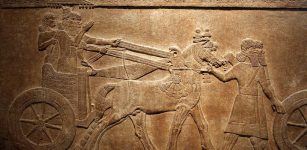 Pax Assyriaca: Important Time For The Neo Assyrian Empire And Surrounding Regions
Ancient History Facts | Aug 11, 2016
Pax Assyriaca: Important Time For The Neo Assyrian Empire And Surrounding Regions
Ancient History Facts | Aug 11, 2016 -
 Tuchulcha: Wicked, Hideously Grotesque Etruscan Demon Identified With Both Male And Female Genders
Featured Stories | Jun 11, 2023
Tuchulcha: Wicked, Hideously Grotesque Etruscan Demon Identified With Both Male And Female Genders
Featured Stories | Jun 11, 2023 -
 Fulani: Africa’s Pastoralists Traced To Green Sahara Period,12,000 – 5,000 Years Ago
DNA | Feb 26, 2025
Fulani: Africa’s Pastoralists Traced To Green Sahara Period,12,000 – 5,000 Years Ago
DNA | Feb 26, 2025 -
 Djémila – Lost City Of The Ancient Kingdom Of Numidia
Featured Stories | Jun 28, 2021
Djémila – Lost City Of The Ancient Kingdom Of Numidia
Featured Stories | Jun 28, 2021 -
 Dwarka – Pre-Harappan City That Could Rewrite The History Of The World
Civilizations | Aug 19, 2014
Dwarka – Pre-Harappan City That Could Rewrite The History Of The World
Civilizations | Aug 19, 2014 -
 Neanderthals Had Capacity To Speak And Understand Language Like Humans
Archaeology | Mar 2, 2021
Neanderthals Had Capacity To Speak And Understand Language Like Humans
Archaeology | Mar 2, 2021 -
 Exceptional 1,700-Year-Old Roman Mosaics Have Returned Home To Israel
Archaeology | Jun 27, 2022
Exceptional 1,700-Year-Old Roman Mosaics Have Returned Home To Israel
Archaeology | Jun 27, 2022 -
 Longvek – Ancient Historical City That Sheds Light On Cambodia’s ‘Dark Age’
Archaeology | Jan 13, 2016
Longvek – Ancient Historical City That Sheds Light On Cambodia’s ‘Dark Age’
Archaeology | Jan 13, 2016 -
 Mysterious Circular Neolithic Structure Used For Unknown Purpose Found In Marliens, France
Archaeology | Apr 16, 2024
Mysterious Circular Neolithic Structure Used For Unknown Purpose Found In Marliens, France
Archaeology | Apr 16, 2024 -
 Has A Second Sphinx Been Found In Egypt?
Archaeology | Nov 5, 2021
Has A Second Sphinx Been Found In Egypt?
Archaeology | Nov 5, 2021 -
 King Charles II Of England Banned Coffeehouses In 1675
Ancient History Facts | Jun 18, 2018
King Charles II Of England Banned Coffeehouses In 1675
Ancient History Facts | Jun 18, 2018 -
 Cuchulainn: Irish Mythical Hero And His Cruel Magical Spear Gae Bolg
Celtic Mythology | Jun 6, 2017
Cuchulainn: Irish Mythical Hero And His Cruel Magical Spear Gae Bolg
Celtic Mythology | Jun 6, 2017 -
 Peculiar Accounts Of Ancient Flying Metallic Dragons And Bells In China And Japan
Ancient Mysteries | Dec 27, 2018
Peculiar Accounts Of Ancient Flying Metallic Dragons And Bells In China And Japan
Ancient Mysteries | Dec 27, 2018 -
 Egyptians Mastered Medicine Thousands Of Years Ago
Civilizations | Oct 1, 2015
Egyptians Mastered Medicine Thousands Of Years Ago
Civilizations | Oct 1, 2015 -
 3,800-Year-Old Wall Relief Created By Ancient Caral People Unearthed In Peru
Archaeology | Aug 28, 2018
3,800-Year-Old Wall Relief Created By Ancient Caral People Unearthed In Peru
Archaeology | Aug 28, 2018 -
 Rare Byzantine Gold Coin Discovered In Norway – Was It Brought By Harald Hardrada From Constantinople
Archaeology | Dec 12, 2023
Rare Byzantine Gold Coin Discovered In Norway – Was It Brought By Harald Hardrada From Constantinople
Archaeology | Dec 12, 2023 -
 Two Rare Funerary Busts Rescued From Destruction In Palmyra – Restored In Italy
Archaeology | Feb 25, 2017
Two Rare Funerary Busts Rescued From Destruction In Palmyra – Restored In Italy
Archaeology | Feb 25, 2017 -
 Rare Collection Of Roman Coins Unearthed In Ancient City Of Aizanoi, Turkey
News | Feb 4, 2021
Rare Collection Of Roman Coins Unearthed In Ancient City Of Aizanoi, Turkey
News | Feb 4, 2021 -
 Forbidden Ancient Manuscripts Almost Erased From History – Secret Teachings Of Mysterious Founder – Part 1
Ancient Mysteries | May 10, 2018
Forbidden Ancient Manuscripts Almost Erased From History – Secret Teachings Of Mysterious Founder – Part 1
Ancient Mysteries | May 10, 2018 -
 Excavations Reveal New Artifacts That Change History Of Ancient City Of Pergamon
Archaeology | Jul 4, 2020
Excavations Reveal New Artifacts That Change History Of Ancient City Of Pergamon
Archaeology | Jul 4, 2020

